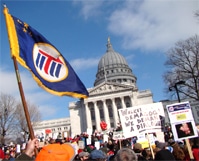
From June 30 to July 2, Transportation Division delegates will be attending a convention in San Diego, Calif., to elect officers of the Transportation Division and to approve recommendations for changes to the SMART Constitution. The Transportation Division convention will be held at the Hilton San Diego Bayfront Hotel.
For hotel reservations and Transportation Division Convention information, click here.
Transportation Division delegates will also participate in SMART’s first convention following the merger of the United Transportation Union and the Sheet Metal Workers International Association, working side-by-side with delegates from the SMWIA. That convention will be held August 11-15 in Las Vegas at Caesar’s Palace.
More information about the conventions will be made available on this page as details are completed.
- Videos embody theme of ‘Strong, Proud, United’ (07/18/14)
- Delegates: Get a feel for SMART convention (07/16/14)
- FRA’s Szabo addresses SMART Convention delegates (07/11/14)
- Notice to locals about SMART Convention credentials (05/23/14)
- SMART TD convention credentials mailed (05/22/14)
- Guest registration for the SMART Transportation Division Convention, San Diego, Calif., June 30-July 2, 2014
- SMART Convention/Constitution FAQs (03/18/14)
- Amending the SMART Constitution’s Article 21B (01/24/14)
- To view the new SMART Constitution (01/14/14), click here.
- To view the UTU Constitution (01/01/11), click here.
- Locals need delegate, seal prior to convention (10/18/13)
 The plan states that all current debt will be wiped out going forward, but does not state how that will be done. NewCo also plans to downsize employees to a “core group” and will get rid of over half of their current fleet of 56 airplanes and resume operation with just 25 planes.
The plan states that all current debt will be wiped out going forward, but does not state how that will be done. NewCo also plans to downsize employees to a “core group” and will get rid of over half of their current fleet of 56 airplanes and resume operation with just 25 planes.![mta_long-island-railroad-logo[1]](https://www.smart-union.org/wp-content/uploads/2013/07/mta_long-island-railroad-logo1.jpg) About 600 Long Island Rail Road retirees will lose their disability benefits after a federal agency voted last week to halt the payments, amid a sweeping investigation into what prosecutors have called a major disability fraud scheme, according to agency documents and officials.
About 600 Long Island Rail Road retirees will lose their disability benefits after a federal agency voted last week to halt the payments, amid a sweeping investigation into what prosecutors have called a major disability fraud scheme, according to agency documents and officials.
